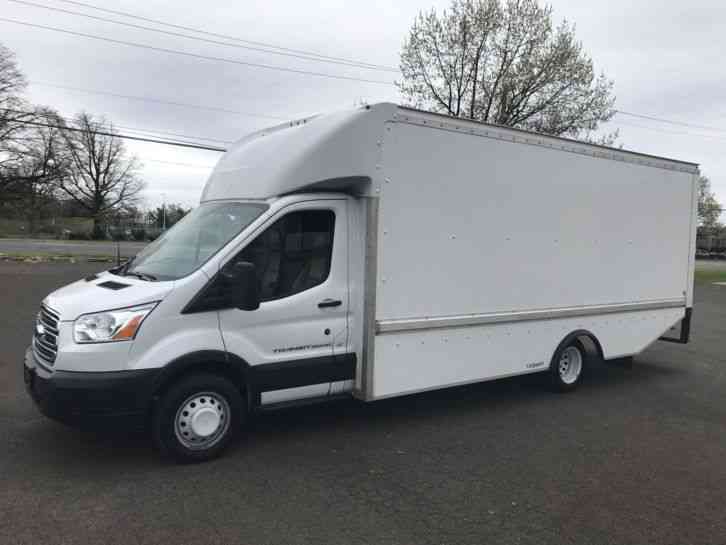Cutaway Box Trucks For Sale: Your Comprehensive Guide to Finding the Perfect Commercial Vehicle pickup.truckstrend.com
In the dynamic world of commerce, efficient transportation is not just a convenience; it’s a cornerstone of success. From last-mile delivery services to mobile workshops and specialized food vendors, businesses across countless sectors rely on versatile, dependable vehicles to get their goods and services where they need to be. Among the most popular and adaptable options available are cutaway box trucks. These workhorses offer a unique blend of maneuverability, customizable cargo space, and cost-effectiveness, making them a prime choice for businesses of all sizes looking to optimize their operational logistics.
This comprehensive guide will delve into everything you need to know about cutaway box trucks for sale, from understanding their fundamental design and benefits to navigating the purchasing process, exploring common applications, and providing practical advice to ensure you make an informed investment.
Cutaway Box Trucks For Sale: Your Comprehensive Guide to Finding the Perfect Commercial Vehicle
What Exactly is a Cutaway Box Truck?
A cutaway box truck, often simply called a "box truck" or "cube van," is a type of commercial vehicle characterized by its distinct two-part construction. Unlike integrated vans where the cab and cargo area are a single unit, a cutaway chassis cab begins life as a bare chassis, similar to a pickup truck, but with an incomplete body behind the driver’s seat. The "cutaway" refers to the fact that the original van body is "cut away" or removed behind the front seats, leaving an open frame.
On this chassis, a separate, enclosed rectangular cargo "box" is then mounted. This modular design allows for immense flexibility. The front portion typically consists of a standard van cab (like those found on Ford E-Series, Chevrolet Express, or Ram ProMaster chassis), providing a familiar driving experience. The rear box, however, can be custom-built to specific dimensions, materials, and internal configurations, making it adaptable to a vast array of business needs.
This design offers significant advantages over both smaller cargo vans (which have limited space and less customization potential) and larger straight trucks (which can be more challenging to maneuver and often require a Commercial Driver’s License or CDL).
Why Choose a Cutaway Box Truck? Benefits and Advantages
The popularity of cutaway box trucks stems from a compelling list of benefits that cater directly to the demands of modern businesses:
- Unmatched Versatility and Customization: This is the primary draw. The separate box allows for specific upfits, whether it’s shelving and bins for a service truck, refrigeration units for food delivery, ramp and tie-downs for moving, or even a full kitchen setup for a food truck.
- Optimal Cargo Capacity: Cutaway box trucks offer significantly more cargo volume than standard cargo vans, allowing businesses to transport more goods per trip, reducing operational costs and increasing efficiency.
- Maneuverability: While offering ample cargo space, many cutaway box trucks are built on light- or medium-duty chassis, making them relatively easy to drive and navigate through urban environments, residential streets, and parking lots where larger trucks would struggle.
- Accessibility: Most box trucks feature a lower deck height compared to heavy-duty straight trucks, making loading and unloading easier, especially when equipped with ramps, liftgates, or side doors.
- Driver Familiarity and Comfort: The front cab often resembles a large van, providing a familiar driving experience for drivers accustomed to standard vehicles, reducing the learning curve and improving comfort during long shifts.
- Cost-Effectiveness: For many applications, a cutaway box truck provides the ideal balance between capacity and cost. They are generally less expensive to purchase and operate than larger, heavier-duty trucks, while offering superior utility compared to smaller vans.
- Durability and Longevity: Built on robust commercial chassis, these trucks are designed for continuous, heavy-duty use, promising a long operational life with proper maintenance.

Common Applications and Industries
The adaptability of cutaway box trucks makes them indispensable across a wide range of industries:
- Last-Mile Delivery Services: E-commerce boom has made these trucks vital for delivering packages, furniture, and appliances directly to consumers’ homes.
- Moving and Storage: Their spacious, enclosed boxes are perfect for transporting household goods during residential or commercial moves.
- Food and Beverage Distribution: Refrigerated or insulated box trucks are essential for delivering perishable goods, catering supplies, and beverages.
- Service Industries: Plumbers, electricians, HVAC technicians, mobile mechanics, and general contractors use them as mobile workshops, carrying tools, equipment, and parts.
- Retail and Wholesale Distribution: Transporting goods between warehouses, stores, and customers.
- Landscaping and Construction: Hauling equipment, tools, and materials to job sites.
- Mobile Businesses: Transformed into food trucks, mobile pet grooming vans, mobile libraries, or pop-up retail shops.
- Recreational Vehicle (RV) Conversions: The bare chassis is a popular starting point for custom RV builds, offering more space and flexibility than traditional van conversions.

Key Considerations When Buying a Cutaway Box Truck
Purchasing a cutaway box truck is a significant investment that requires careful planning. Here are crucial factors to consider:
- Gross Vehicle Weight Rating (GVWR): This is paramount. GVWR is the maximum operating weight of the truck as specified by the manufacturer, including the vehicle’s chassis, body, engine, fuel, passengers, and cargo. Ensure the GVWR matches your intended payload. Trucks with a GVWR of 26,001 lbs or more generally require a CDL. Most cutaways fall under this threshold, but always check.
- Box Dimensions and Volume: Determine the optimal length, width, and interior height of the box based on the type, size, and quantity of goods you’ll transport. Consider clearance for loading/unloading.
- Engine Type (Gas vs. Diesel):
- Gasoline Engines: Generally lower upfront cost, easier to maintain, quieter, and perform well for lighter loads and shorter, frequent stops.
- Diesel Engines: Higher upfront cost, better fuel economy (especially under heavy loads or long distances), more torque, and greater longevity. Ideal for heavy hauling and extensive mileage.
- Door Types and Loading Access:
- Roll-up Doors: Common for quick access, but can reduce usable interior height.
- Swing-out Doors: Offer full access to the opening, but require space behind the truck to open.
- Liftgates: Essential for heavy or bulky items, available in various capacities and types (tuckaway, rail).
- Ramps: For lighter, wheeled items or for easy access for personnel.
- Side Doors: Useful for multi-compartment setups or quick access to specific items.
- Interior Features and Upfits: Consider E-track systems for securing cargo, interior lighting (LED is efficient), shelving, partitions, temperature control (refrigeration/heating), and non-slip flooring.
- Condition (New vs. Used):
- New: Full warranty, latest technology, no immediate maintenance concerns, but higher initial cost.
- Used: More affordable, faster depreciation already occurred, but requires thorough inspection and potential immediate repairs. Check mileage, maintenance records, and overall wear and tear.
- Brand and Model Reputation: Research reputable manufacturers known for durability and availability of parts, such as Ford E-Series, Chevrolet Express, and Ram ProMaster cutaway chassis.
- Budget: Factor in not just the purchase price but also financing costs, insurance, fuel, maintenance, and potential upfitting expenses.
Where to Find Cutaway Box Trucks for Sale
Finding the right cutaway box truck requires knowing where to look:
- Commercial Truck Dealerships: Both new and used commercial vehicle dealers specialize in these trucks and can offer financing, warranties, and upfitting services.
- Online Marketplaces: Websites like TruckPaper.com, CommercialTruckTrader.com, and eBay Motors list thousands of commercial vehicles from dealers and private sellers nationwide.
- Auctions: Government surplus auctions, fleet auctions, and public auctions can be sources for good deals, but often require cash payment and offer vehicles "as-is."
- Direct from Businesses: Keep an eye out for "For Sale" signs on trucks being retired from service by local businesses.
- Specialized Upfitters: Companies that custom-build truck bodies sometimes have completed units for sale or can source a chassis for you.
Tips for a Successful Purchase
- Define Your Needs Precisely: Before you even start looking, clearly outline what you’ll be hauling, how much it weighs, the distances you’ll travel, and any specific operational requirements.
- Thorough Inspection (Especially for Used): If buying used, either perform a detailed inspection yourself or, ideally, hire a qualified commercial truck mechanic to do a pre-purchase inspection. Look for rust, fluid leaks, tire wear, brake condition, and structural integrity of the box.
- Test Drive: Always test drive the truck, loaded if possible, to assess engine performance, transmission shifting, braking, steering, and overall handling. Listen for unusual noises.
- Review Documentation: Verify the VIN, check service records, and ensure the title is clean. Consider a vehicle history report.
- Negotiate: Don’t hesitate to negotiate the price. Be prepared to walk away if the deal isn’t right.
- Understand Financing Options: Explore commercial truck loans, lines of credit, or leasing options that might be available through dealerships or banks.
- Plan for Insurance: Commercial vehicle insurance differs significantly from personal auto insurance. Get quotes early to factor this cost into your budget.
Estimated Price Range for Cutaway Box Trucks
Prices for cutaway box trucks vary widely based on whether they are new or used, their GVWR, engine type, mileage, condition, brand, and the specific features/upfits of the box. The table below provides a general estimated range:
| Category | GVWR Range (Approx.) | Typical Mileage (Used) | Key Features/Condition | Estimated Price Range (USD) | Notes/Considerations |
|---|---|---|---|---|---|
| New Light-Duty | 10,000 – 14,500 lbs | N/A | Basic Box (12-16 ft) | $45,000 – $70,000+ | Ford E-350, Chevy Express 3500 chassis; gasoline engine. |
| New Medium-Duty | 14,501 – 26,000 lbs | N/A | Basic Box (16-20 ft) | $60,000 – $90,000+ | Ford E-450, Chevy Express 4500 chassis; gas or diesel. |
| Used Light-Duty | 10,000 – 14,500 lbs | 100,000 – 200,000 miles | Basic Box, Good Cond. | $15,000 – $35,000 | Price varies greatly by age, condition, and market. |
| Used Light-Duty | 10,000 – 14,500 lbs | 50,000 – 150,000 miles | W/ Liftgate or Refurb. | $25,000 – $50,000 | Added features increase value; inspect specialized eq. |
| Used Medium-Duty | 14,501 – 26,000 lbs | 150,000 – 300,000 miles | Basic Box, Fair Cond. | $20,000 – $45,000 | Often diesel; potential for higher mileage. |
| Used Medium-Duty | 14,501 – 26,000 lbs | 100,000 – 250,000 miles | W/ Refrigeration Unit | $35,000 – $70,000+ | Specialized units hold value, but maintenance is key. |
| Older/High Mileage | Varies | 250,000+ miles | "As-is" or Project | $5,000 – $15,000 | Best for those with mechanical skills or low budget. |
Note: These are estimates and actual prices can fluctuate based on market demand, location, specific features, and the truck’s overall condition.
Frequently Asked Questions (FAQ) About Cutaway Box Trucks
Q: What’s the difference between a cutaway box truck and a straight truck?
A: A cutaway box truck is built on a lighter-duty, "cutaway" chassis (like a heavy-duty van chassis), typically having the cab integrated with the front of the vehicle. A straight truck (also called a "cube truck" or "box truck" in some contexts) generally refers to a heavier-duty truck chassis designed specifically for commercial bodies, often with a separate cab or a cab-over-engine design, and typically higher GVWRs. Many cutaways are box trucks, but not all box trucks are cutaways.
Q: Do I need a CDL (Commercial Driver’s License) to drive a cutaway box truck?
A: Most cutaway box trucks fall into the non-CDL class, meaning their GVWR is typically below 26,001 pounds. However, it’s crucial to check the specific GVWR of the truck you intend to purchase. If the GVWR exceeds 26,000 lbs, or if it’s transporting hazardous materials requiring placards, a CDL will be required. Always verify state and federal regulations.
Q: Can I customize the interior of a cutaway box truck?
A: Absolutely! Customization is one of their biggest advantages. The empty box can be upfitted with shelving, workbenches, refrigeration units, insulation, E-track systems, custom lighting, specialized flooring, and more, to suit almost any business need.
Q: What’s considered good mileage for a used cutaway box truck?
A: For a used commercial truck, mileage isn’t the only factor; maintenance history is arguably more important. However, a gasoline cutaway with 100,000-150,000 miles can still have significant life left if well-maintained. Diesel engines can often last well over 300,000-400,000 miles with proper care. Always get a pre-purchase inspection.
Q: Are cutaway box trucks good for RV conversions?
A: Yes, very much so! The cutaway chassis provides a robust and spacious platform for RV conversions, offering more interior width and height than standard cargo vans, and a blank canvas for custom layouts. Many DIY and professional RV builders prefer them for their versatility and payload capacity.
Q: What are the common issues to look for in a used cutaway box truck?
A: Beyond general mechanical wear (engine, transmission, brakes), specifically check for: frame rust, cracks in the box structure, water leaks in the box, condition of the roll-up or swing-out door mechanisms, functionality of the liftgate (if equipped), and proper operation of refrigeration units (if applicable).
Conclusion
Cutaway box trucks stand as a testament to practical engineering, offering unparalleled versatility and efficiency for businesses in a myriad of sectors. Whether you’re a burgeoning e-commerce venture, an established moving company, a mobile service provider, or a budding food truck entrepreneur, these vehicles provide a robust and customizable platform to meet your specific operational demands.
By understanding the distinct advantages of cutaway box trucks, carefully considering key factors like GVWR and box dimensions, and employing smart purchasing strategies, you can secure a valuable asset that will drive your business forward for years to come. Investing in the right cutaway box truck isn’t just buying a vehicle; it’s investing in the future growth and logistical backbone of your enterprise.




